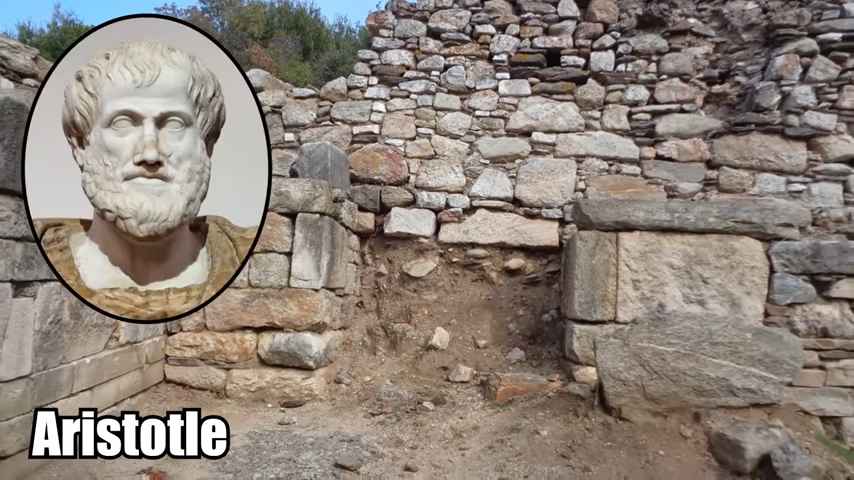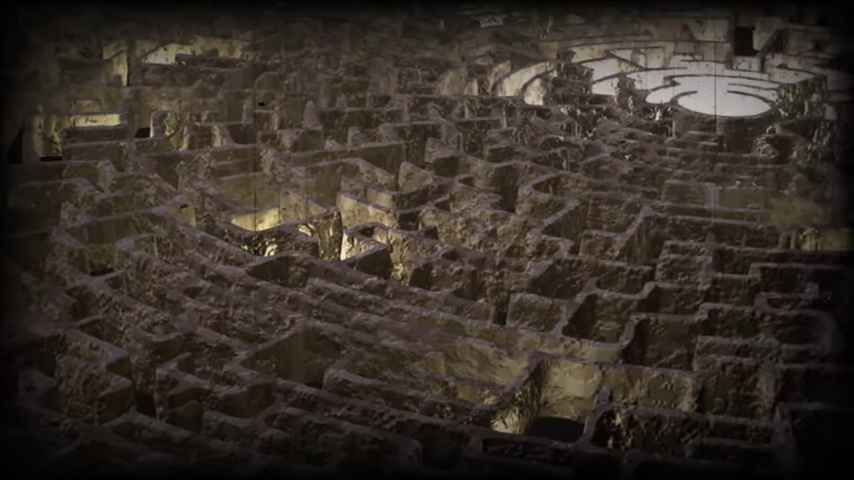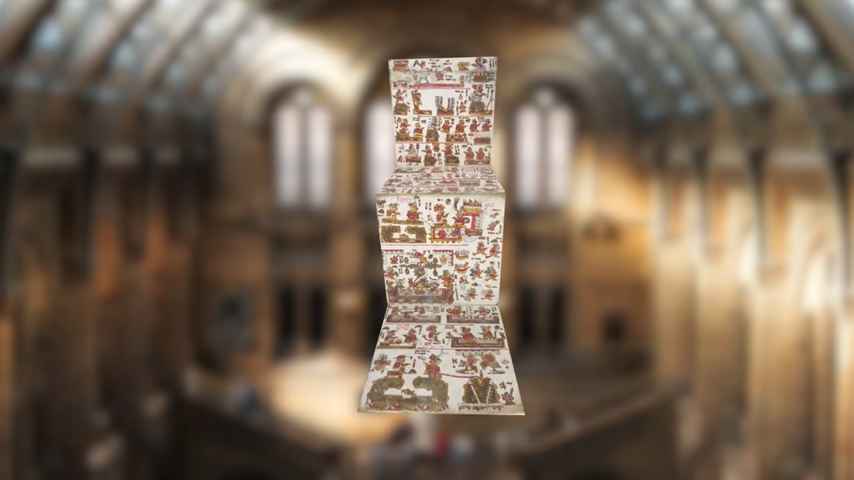10: Tree Trunk Coffin
In July of 2019, renovations at a golf course in Tetney, England, revealed something shocking. While construction workers were revamping a stinky old pond at the golf course, they uncovered a wooden coffin from 4000 years ago. According to a statement from the University of Sheffield, this was a sarcophagus that contained human remains, an old war axe, and bedding of plants meant to be a comfortable bed for the deceased. The coffin was created from a hollowed oak tree trunk and then buried underneath a mound of gravel. This type of burial was usually reserved for the most important members of society during the Bronze Age. Just like the amazing foundations that were uncovered in London, this ancient artifact had been hiding in plain view for decades. People had literally been shooting golf balls into the pond where the coffin was buried. Nobody knows who exactly was buried inside the coffin. The human remains were extremely decayed, and there isn't really written history from 4000 years ago. All we know is that the grave probably belonged to a local chieftain. When archaeologists finish restoring it, the coffin will be going on display at the Collection Museum in Lincoln.
9: Aristotle's Tomb
During recent digs in Macedonia, archaeologists came across a mysterious tomb that some believe might actually be the final resting place of the legendary philosopher Aristotle. If true, this could be one of the most significant accidental discoveries in years. Excavations were ongoing at the site of Stagira, in what is today central Macedonia. This region was a part of Ancient Greece thousands of years ago, about 2400 years before today, when the great philosopher died. The archaeologist behind this discovery is Kostas Sismanidis, who's actually been obsessed with the archaeological site since 1996. However, it wasn't until 2016 that he uncovered evidence of Aristotle's tomb. What makes this theoretical discovery even more likely to be true is that Aristotle was born in this exact place in the year 384 BC. Even though he died in the city of Chacis in 322 BC, his ashes were likely brought to Stagira, where he’d been born and then put inside of a tomb. But over the years, the tomb was forgotten and it eventually turned into more of a ruin. The tomb just discovered by archaeologists was definitely extravagant enough at one point to have been worthy of Aristotle. It was a shining marble structure with a great domed ceiling, complete with a 360-degree-view of the city below. However, nobody has been able to authenticate the tomb 100%. All we really know is that it belonged to someone important, and that important person really could have been Aristotle.
8: The Althorp Estate
The Althorp Estate was the childhood home of Princess Diana. It's one of the most important places anywhere in England. As it turns out, the estate itself happens to be on a very large piece of land, which archaeologists have been exploring. What they recently found completely by accident is nothing short of amazing. First of all, the Althorp Estate has been home to the Spencer family since 1508. However, archaeologists now know that on the grounds of this immense estate, there was once a village from the 14th century and a potential settlement used by Neanderthals 40,000 years ago. The more recent settlement was actually what archaeologists were searching for. It's called Olletorp, and historical texts say that the small village was completely annihilated by the Black Death in the 14th century. But it was while looking for evidence of this medieval town that the archaeologists discovered evidence of Neanderthal activity. They had not been expecting that! For those who don't know, Neanderthals are believed to be our closest relative. They mysteriously died out, between 40,000 and 44,000 years ago. It was right around their time of extinction that they had been living on the grounds of the Althorp Estate. Archaeologists found seashells and antlers, as well as pieces of flint, in an ancient garbage dump. The discovery is proof that Neanderthals had been making tools at this location, probably from the bones, shells, and antlers of animals that they killed and ate!
7: Lactose Intolerant Mummified Man
Erika and Helmut Simon went on a hiking adventure in the Otztal Alps, Austria. It was literally just supposed to be a hiking trip. They had never anticipated that they would stumble upon a fantastic discovery 5000 years in the making. They were nearing the end of their journey when they took a shortcut across the mountains and accidentally found a human body sticking out from a rocky gully at over 9000 feet above sea level. His left arm was all twisted, he was frozen solid, and he looked to have only been dead for a few days. After making the terrible discovery, the mountain climbers got a hold of the Austrian authorities to let them know. When they went to investigate, they also thought the person frozen in ice was just a lost mountaineer. But as it turned out, this was a caveman, a literal ancient person who probably lived in caves 5300 years ago. The authorities were suspicious when they realized he had been frozen with a flint dagger, a copper axe, and a container made from birch bark that had probably held his prehistoric lunch. He also had with him a longbow, a quiver, and a few arrows. Obviously, this guy didn't just die a few days ago. The initial examination was done by an expert named Konrad Spindler, who dated the deceased person at 4000 years old. It was later that carbon dating revealed him to be significantly older. CT scans on his body showed three bouts of sickness in the six months before his death, and DNA investigations revealed he was lactose intolerant. Based on tissue samples, he died sometime around 3239 BC, then was frozen solid ever since. He is still the best-preserved mummy that has ever been discovered, and it was a total accident.
6: The Minotaur's Labyrinth
One of the most famous Greek myths is about the minotaur and the labyrinth. The legend says that King Minos of Crete created the most fantastic labyrinth ever seen to house the minotaur. The minotaur was a punishment sent by the gods and the result of his wife's affair with a bull. It's complicated! Up until recently, nobody was really sure if there had ever been a labyrinth built on the Greek island of Crete. But now, archaeologists investigating an abandoned stone quarry believe they may have found the original site of the labyrinth. And if the labyrinth is real, then just maybe the minotaur was too. The abandoned quarry is near the small town of Gortyn, close to the southern tip of the island. The archaeologists found a complex network of underground passages that could have actually been part of a massive maze. Nobody had found it before because archaeologists were too busy on the other side of the island, investigating the ruins of the legendary palace of Knossos, where King Minos may have actually lived. Unfortunately, there's no real way to know if the labyrinth was used for storing some kind of wild animal. We can't ever know for sure if it was the great labyrinth from the Greek myth. But there was definitely some kind of tunnel system here, and it could have been a vast, inescapable labyrinth!
5: The Precolonial Mexican "Book"
Researchers with the University of Oxford were recently experimenting with highly advanced imaging technology to uncover details about a rare Mexican codex, or book. The Mexican codex dates from before the Americas were ever colonized by the Europeans. Amazingly, it's been hidden from the eyes of outsiders for just about 500 years. The code was concealed beneath a layer of plaster on the back of a manuscript called the Codex Selden. It was hidden, completely invisible to the human eye. It wasn't until scientists used hyperspectral imaging that they uncovered the pictographic scenes hidden beneath the plaster. Think of it like invisible ink, except with a manuscript written on a piece of deer hide. The original hide had been used as a 20-page document – but was later covered up with plaster and reused to make the Codex Selden. The codex was from around 1560, one of only five examples that still survive from the Mixtec area of ancient Mexico, what is today Oaxaca. The codex is a list of dynasties and genealogies throughout the local history, kind of like a record of everyone's families and the ruling parties. It's the best window archaeologists have into Mexico's ancient past. But because the writing consists of pictures and symbols instead of letters, it's quite difficult to decipher. As for what scientists found beneath the more recent document, it's just more pictures and symbols that they have not been able to translate. They know that the original manuscript was probably quite similar to the Codex Selden, but they don't know what it all means.
4: Gladiator Graves
The old city of Ephesus, in what is today Turkey, was once a central power in the ancient world. It also happened to be the capital of the Roman province of Asia. It was famous for having epic gladiatorial games. Archaeologists have found graffiti on marble walls all throughout the ancient city depicting gladiators fighting in the arena. They held chariot races, death games, and all kinds of gladiator fun here. In 1993, archaeologists were excavating the city's necropolis when they made a rather unusual discovery. For the first time in history, they found a burial ground completely dedicated to gladiators. Of course, archaeologists have found plenty of gladiator graves throughout ancient Rome “ just not a dedicated cemetery. The graves had tombstones that showed the deceased as being gladiators, with inscriptions that verified their identities. According to director of excavations Martin Steskal, they even analyzed their bones and found they matched other bones from ancient gladiators. The graves date back to around the 2nd century, to a time when gladiators were getting extremely popular. And they weren't only criminals or prisoners of war, some were also in it for the money. Many people became famous and rich because of their fighting abilities, and many of those people were buried here in this gladiator graveyard.
3: The Lost Golden City
Archaeologists in Egypt have discovered a lost golden city from 3400 years ago. This was once a royal metropolis designed and built by the ruler Amenhotep III, only to be abandoned by his son, Akhenaten. Akhenaten abandoned his family name, the Egyptian religion, and the city his father built. He founded his own city, his own religion, and tried to change Egypt during his 17 years of rule. Oddly enough, his son “ the boy king Tutankhamun “ then abandoned everything his father had done and went back to the old ways. During all this confusion, Amenhotep III's new golden city was lost and forgotten. It was then buried under the desert sands and ignored until rediscovered by archaeologists in the 21st century. According to Dr. Zahi Hawass, people had been searching for this city for decades and had never found it. But- in September of 2020, archaeologists came across it in the desert completely by accident. It was Dr. Hawass himself who was leading an Egyptian team in search of Tutankhamun's Mortuary temple when he came across the foundations of Amenhotep III's city. They found formations of mud bricks, crumbling walls, and rooms filled with relics from everyday Egyptian life. All these treasures had been untouched for thousands of years. Because the discovery is so new, researchers are still poring over the evidence. Archaeologists are still looking at the hieroglyphic inscriptions found on scraps of clay, they're still uncovering more and more neighborhoods, and they're still working to get a clear picture of this short-lived, and long sought capital.
2: A Solar Bowl
A team of German archaeologists recently uncovered a spectacular gold bowl decorated in sun motifs. The bowl was found in a mysterious settlement in Austria, dating back to the Bronze Age. As of right now, this is the first solar bowl ever found in the country, and archaeologists are struggling to figure out what its function once was. The settlement where it was found is so old that writing hadn't even made it into the area yet, so there are no written records explaining the functions of the society. While this may not sound that exciting to you, the person who found it declared it was the discovery of a lifetime!! Not only was the bowl found by accident, but so too was the settlement. Workers were called in to help build a train station, but had to put the project on hold when they found archaeological evidence. What is now a dry stretch of land was once a swamp, likely inhabited by a group of sun-worshipping pagans. These types of bowls have been found in other parts of Europe, such as Germany and Denmark. And in almost every case, the bowls with the sun motifs were part of religious ceremonies in which people gave praise to the almighty sun. This was over 3000 years ago, during a time when Europe was lacking in organized religion.
1: Foundations of Londinium
Archaeologists investigating a building site in England accidentally uncovered a Roman house from the year 72. That was about 25 years after the Roman invaders founded the city of Londinium, the original city of London. Staff with the Museum of London Archaeology have discovered that the building had at least four rooms, it contained a courtyard, and it was surrounded by gardens. Some of the walls were found with badly worn paintings of flowers, while some of the floors still had mosaic tiles. Nobody can say for certain what the building was, though some speculation says it may have been an upper-class hotel used by visiting Romans. It may also have been a kind of barracks for high-ranking military members. Archaeologists discovered a phallic-shaped pendant, which was often used as a symbol of the Roman army. But of course, it could have also just been a private home. The building stood probably for about 150 years before being covered over and replaced with something else. The really amazing thing is that its ruined foundations had been hiding underneath London’s city streets for the past 2000 years without anyone knowing. Who knows what else is down there!! Which of these amazing forgotten sites would you love to visit yourself? Let me know in the comments and thanks so much for watching. If you haven't already, remember to hit the subscribe button for more of the most amazing posts!
















0 Comments